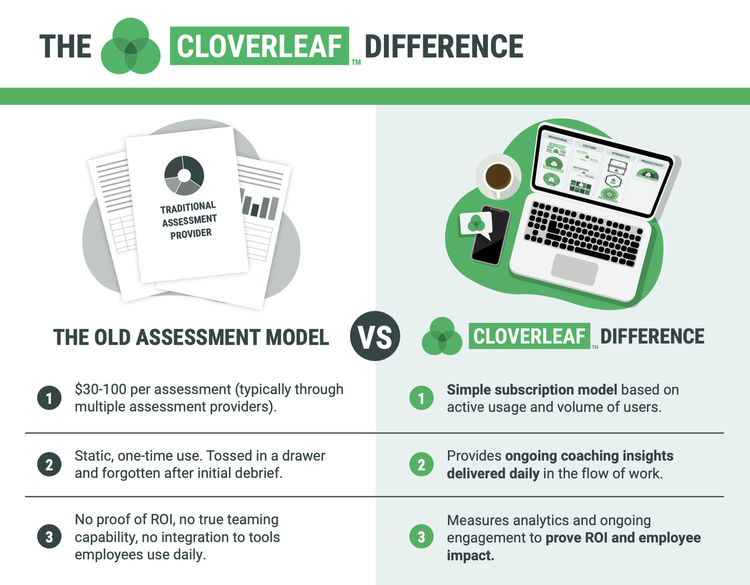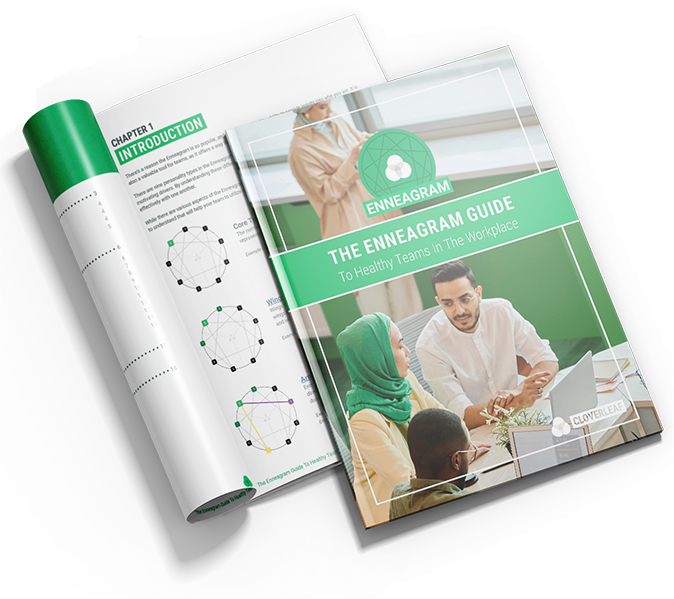The Enneagram does what a typical personality test doesn’t by exposing what drives decisions and behavior. It taps into your emotional intelligence and how you conceptualize the world and conform it to one of nine distinct personality types.
The Enneagram can be highly beneficial in the workplace, helping you better serve your teammates, peers, and clients. The assessment gives insight into each person’s perspectives and motivations, aiding communication and cohesiveness.
The Enneagram personality tool can be extremely helpful in the workplace, allowing you to better serve your teammates, peers, and clients. The test gives you insight into each person’s perspectives and motivations, aiding in communication and cohesiveness.
This article will help you incorporate the Enneagram into your workplace by explaining the value of starting the discussion, tips on starting the conversation, and stressing the importance of relationship building.
Lastly, we’ll discuss the nine enneagram types and how their personalities intertwine with their work.
The Value of Discussing Enneagram Types at Work
The Enneagram model reveals more than what you see on the surface level. Although you may think you know and understand someone by the personality traits and patterns they display, without knowing their internal motivations, you can’t truly support or lead them as a teammate or leader.
When you discuss Enneagram types at work, you open up the possibility for empathy, compassion, and understanding. A team that works well together performs better, communicates better, and enjoys more purpose-filled work.
By openly discussing Enneagram types, you can better understand yourself and others and gain insight into motivations and behaviors. You’ll see an overall improvement in conflict resolution, teamwork, and morale.
However, starting this conversation may be more challenging than it seems. Many people struggle to open up and be vulnerable in professional settings.
While you can’t force anyone to participate, the long-term reward of a cohesive team far outweighs the short-term inconvenience of being vulnerable.
Do you need help navigating your work relationships or developing a work culture where people can thrive? Download the free Enneagram Guide To Healthy Teams In The Workplace.
THE ENNEAGRAM GUIDE TO HEALTHY TEAMS
Inside this free guide, you’ll learn:
- A breakdown of each Enneagram type and their work style
- How to recognize the motivations of each type to mitigate conflict
- Tips for using the Enneagram to improve communication among team members
- Activities to help develop your team

Relationship Building: The Importance of Getting To Know Your Teammates
By openly discussing and comparing Enneagram types, you can better understand yourself and others and gain insight into motivations and behaviors. You’ll see an overall improvement in conflict resolution, teamwork, and morale.
4 Reasons To Share The Enneagram With Your Team
You Spend A Significant Amount Of Time Together
You likely find that you spend more time with your work team than any other group in your life. The relationships you build with these people can benefit you both short and long-term.
Healthy Work Relationships Reduce Stress
A positive working relationship with your team dramatically reduces the stress and mental energy you exert during a typical workday.
As a result, you spend less time thinking about how to avoid conflict and more time focused on decision-making, which will help your team become efficient.
Authenticity Leads To Better Performance
When you know team members deeper, collective self-doubt goes out the window, and members become more confident when everyone gets to show up at work as their authentic selves.
Feeling Connected As A Team Strengthens Collaboration In The Workplace
Having a personal connection with your teammates is essential because you will feel supported. It’s common for people to feel the need to be self-sufficient in the workplace, but true harmony lies with a team that understands interdependency.
Your work habits and communication strategies depend primarily on fear and internal motivations. When you identify these in yourself and others, you will have better self-awareness and a heightened appreciation for teamwork.
Enneagram Types At Work: Recognizing One Another’s Communication Style, Habits, and Strengths
This model includes nine types of Enneagram styles. Once you learn your Enneagram number, you will better understand your role within your team and can then leverage this knowledge to better yourself and support your team’s growth. If you are still unsure of your type, take our free Enneagram test.
Your work habits and communication strategies depend largely on fear and internal motivations. When you identify these in yourself and others, you will have better self-awareness and a heightened appreciation for teamwork.
Below are the nine Enneagram types, their communication, and how each personality can “show up” at work.
Enneagram Ones at Work
Enneagram Type Ones are referred to as The Reformer. This personality type values hard work, self-control, and setting high standards. They find motivation by being or doing things “right” and fear being imperfect or perceived as wrong.
They’re detail-oriented and typically the person you go to when dealing with difficult situations that require accuracy, quality control, and improvement.
Communication Style
Polite, thoughtful, detailed, and well-formulated. Ones should be mindful that they can become demanding because they have high expectations. Encouraging a One to share their perspective openly can help the team mitigate potential risks.
Under Stress: Move to Four
Stress impacts Ones with a sense of hopelessness, and they become their own worst critics.
When Secure: Move to Seven
When Ones feel secure, they lighten up and are more spontaneous.
Type Ones are people of practical action who are always concerned with doing the right thing. One’s are efficient, organized, and dependable to complete the task.
They do things in a professional, honest and ethical manner. Ones have a knack for creating structures that allow others to thrive.
Enneagram Twos at Work
Enneagram Type Twos are known as The Helper. They are positive, people-oriented individuals invested in the feelings and needs of others. Twos are motivated by being needed and fear feeling rejected by others.
Communication Style
Relational, caring, demonstrative, and supportive. The perceived health of their relationships influences how they communicate with others. They prioritize expressing care and are grateful when others do the same; a thank you can go a long way.
Under Stress: Move to Eight
Stress causes Twos to become aggressive (especially when they don’t feel
appreciated), resulting in attempting to blame or control others.
When Secure: Move to Four
When Twos feel secure, they are more transparent and exhibit creative potential. They can feel and express their full range of emotions responsibly.
This type demonstrates caring and thoughtful behavior and makes it a point to be there whenever you need them. Twos are terrific in roles that require strong people skills, anticipating the needs of others, and social interaction.
A Type Two’s strength can also surface as a weakness. Twos may lack boundaries, losing sight of their ideas, needs, and priorities with lower self-awareness.
They are consummate team players, always opting for self-sacrifice over self-promotion and happy to take on extra work when others are overloaded or in a jam.
Twos are attentive, appreciative, generous, warm, playful, and nurturing. They usually have a large circle of acquaintances and fiercely guard relationships.
Enneagram Threes at Work
Enneagram Type Threes are referred to as The Achiever. These individuals tend to be ambitious, highly productive, and appear as the symbol of success in the workplace.
Threes values appreciation and recognition. Hard work, goal-oriented, organization, and decisiveness are trademarks of this type. They are motivated by admiration and are fearful of lacking value to others.
Communication Style
Straightforward, efficient, focused, and confident. They prepare for meetings to ensure they are clear and goal-focused. It is important to them for others to reciprocate respect and value while communicating.
Under Stress: Move to Nine
Stress can cause Threes to lose focus and be preoccupied with busy work.
When Secure: Move to Six
When Threes feel secure, they are more committed and loyal. They find it easier to identify their emotions and connect with others.
In pursuit of success, Enneagram Threes may railroad others in the workplace, become workaholics, and struggle with accountability.
Threes are energized by being productive, achieving success, and avoiding failure. They can be playful, giving, responsible, and well-regarded by others in the community.
Threes can complete work efficiently and competently to ensure they reach personal goals. A Three has a keen ability to size up tasks and understand the dynamics of work groups. They can also be inspiring and motivate other people to excel.
Enneagram Fours at Work
Enneagram Type Fours are creative, unconventional individuals within a team known as The Originalist. Fours are motivated to express their individuality and demonstrate fear when perceived as ordinary. They value authenticity and stand by their beliefs.
Communication Style
Intense, authentic, creative, and empathetic. Fours have a strong desire to be understood and want to know how those around them feel.
Enneagram Fours value relationships and connections with other people. They seek to experience authentic feelings and to be understood. This type avoids the ordinary and searches for deeper meaning in their work.
Under Stress: Move to Two
When experiencing stress, Fours can become overly dependent upon others and seek assurance.
When Secure: Move to One
When Fours feel secure, they act on their ideals, practice organization, and use self-control.
Fours can also be empathetic in relationships, supportive, gentle, playful, passionate, and witty. They are self-revealing and can form bonds quickly with others.
Type Fours have an innate talent for identifying and expressing a sense of harmony within their surroundings. They have a gift for helping others to see beauty in their work and are great teammates to help identify unexpected solutions to problems that others may overlook.
Enneagram Fives at Work
Enneagram Type Fives are known as The Sage. They are thoughtful, cerebral types who see and interpret the world through information. Fives are motivated by a desire to be competent. They strive to be capable in all aspects and fear looking uninformed.
Fives are independent thinkers and typically enjoy working alone to process and have time to problem-solve. They are good listeners, observant, and help others understand the truth more soberly and objectively.
Communication Style
Brief, professional, objective, and reserved. Fives rely on research, insight, and knowledge before communicating and, therefore, may need time to share the next steps or ideas. This type appreciates the patience and willingness to listen to new perspectives while conversing.
Under Stress: Move to Seven
Stress can cause Fives to be easily distracted and disorganized. It can also cause them to detach themselves from the team.
When Secure: Move to Eight
When Fives feel secure, they will exude more energy and action, take the initiative, and be decisive.
Fives are kind, perceptive, open-minded, self-sufficient, and trustworthy to teammates. They have strong analytical skills and are good at problem-solving. Fives can be very helpful when teams need objectivity, clarification, or exploration of new ideas.
Enneagram Fives are naturally open and receptive to new facts and impressions, discovering new ideas, research, and innovations – particularly those that are provocative, surprising, unconventional, and profound.
Enneagram Sixes at Work
Enneagram Type Sixes are referred to as The Loyalist. They value preparedness and are dependable individuals you can trust with important decisions. This type is most motivated by stability and fears lacking direction.
Sixes possess excellent problem-solving skills and thrive on helping to create solutions. They are adept at identifying potential problems and researching viable solutions.
Communication Style
Inquisitive, witty, logical, and ironic. Sixes prefer to focus on the task at hand and typically are relational in their approach. They appreciate when others value their input and interpret their concern as a desire for the project’s success.
Under Stress: Move to Three
Stress can cause Sixes to discredit their feelings or drive them toward workaholic tendencies.
When Secure: Move to Nine
When Sixes feel secure, they can reframe unnerving thoughts, accept others, and lower their suspicions.
Sixes are warm, playful, open, loyal, supportive, honest, fair, and reliable. They are cooperative individuals willing to do what it takes to support the team.
Sixes value experience and data when considering new solutions or next steps. When deciding, a Six will often look to a book, leader, or institution for reliable answers.
Enneagram Sevens at Work
Enneagram Type Sevens are known as The Enthusiast. They are spontaneous, imaginative, charming people who bring fun to the workplace. They’re motivated to be happy and are fearful of experiencing limitations.
Sevens have a positive outlook on life, and their enthusiasm proves a valuable asset to their team. They see opportunities others may miss but can be impulsive and fail to see projects through.
Communication Style
Fast-paced, energetic, visionary, and confident. Sevens like to keep conversations upbeat. When communicating with them, look for areas of agreement and opportunities that foster synergy.
Under Stress: Move to One
Stress can lead Sevens towards criticism, fault-finding, and narrow-mindedness.
When Secure: Move to Five
When Sevens feel secure, they accept the good and the bad. They can slow their pace and focus.
Sevens are lighthearted, generous, outgoing, and caring. They enjoy sharing new experiences with friends and teammates. This type typically radiates joy and optimism, expresses childlike astonishment, and experiences life as a gift.
Enneagram Eights at Work
Enneagram Type Eights are referred to as The Challenger. These individuals stand up for what they believe in and care about justice. Eights find motivation in remaining in control and fears appearing weak or vulnerable.
Eights often emerge as natural leaders because they are action-takers and can sometimes overstep boundaries to move work forward; however, this can cause relational strain with teammates.
Communication Style
Authoritative, direct, bold, and strategic. Eights communicate in a straightforward, passionate manner. They are comfortable with debate and rarely avoid conflict. To connect with an Eight, share honestly and openly, without hesitation.
Under Stress: Move to Five
Stress causes Eights to withdraw and become rigid. They will lose touch with their emotions and ignore signs that it is time to take a break.
When Secure: Move to Two
When Eights feel secure, they become relatable to others, exhibiting warmth and compassion.
Type Eights are self-reliant, strong, and independent. They can also be loyal, caring, cheerful, and generous. Eights will take the initiative and prefer to be in charge to exercise the freedom to choose what they believe is the right course of action.
Eights can also give others a sense of strength through their positive support. They instinctively know when something is “off” within the environment and do not hesitate when sharing their opinion.
This type often is a source of strength for others, likes to protect the weak, and develops a tremendous sense of responsibility.
Enneagram Nines at Work
Enneagram Type Nines are known as the Peacemaker. They are mediators of the group and thrive when helping differing parties resolve conflict. Their motivation stems from a desire for peace of mind and fears of experiencing overwhelming strife.
Nines can handle difficult conversations and remain level-headed. They are commonly the person people go to when they need a resolution or a second opinion concerning a pressing issue.
Their feelings do not drive them; they have keen instincts that help them gather wisdom to share. Nines are not confrontational but can navigate conflict to ensure both sides feel understood.
Communication Style
Affirming, supportive, easygoing, and diplomatic. Nines are open to others and value their opinions. They enjoy meaningful conversation and appreciate when others reciprocate the same.
Nines can become passive and indecisive when they do not feel understood; therefore, inviting their input is a great way to ensure you receive their counsel.
Under Stress: Move to Six
Stress impacts Nines with a sense of anxiety and indecisiveness. They can begin to overcommit and doubt their abilities.
When Secure: Move to Three
When Nines feel secure, they tend to be more practical, productive, focused, and confident.
Nines want to keep the peace, connect with others, and avoid conflict. Typically, Nines are kind, gentle, reassuring, supportive, loyal, and nonjudgmental. This type can exhibit various characteristics, from gentle and mild-mannered to independent and forceful.
They have excellent listening skills, are objective, and excel at unbiased mediation with the ability to see and appreciate the positive aspects of both sides.

How To Use The Enneagram In your Workplace?
You can use Enneagram in your work environment by openly discussing the types and focusing on how it affects your work habits and relationships. Each person on your team is unique and constantly evolving. For additional ideas, check out the post, 4 Effective Enneagram Activities To Help Develop Your Team.
The Enneagram allows you and your team to do some introspection and collaborate to find the best ways to leverage each other’s strengths for the benefit of the group.
Which Enneagram Types Work Best Together?
Each Enneagram type has the potential to work well with others. Of the nine styles, no two are more compatible than the other. Instead, each individual must choose to be understanding and compassionate to the needs of the other.
Different situations or circumstances arise with different characteristics in each personality type. You can work well with anyone by acknowledging what the other person is motivated by and leveraging those strengths.
Using the Enneagram at work should help you become a better team and understand one another better. Identifying the nine types at work can help teams improve collaboration and teamwork rather than segregating or partnering up with people you find more suitable to your own type.

DOWNLOAD THE ENNEAGRAM GUIDE TO HEALTHY TEAMS IN THE WORKPLACE EBOOK TODAY
- How to understand each Enneagram Type
- Tips for working better together
- Enneagram-based activities to help develop your team
- And more...



